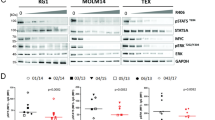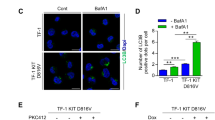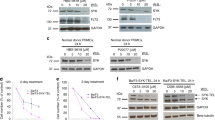Abstract
Spleen tyrosine kinase (SYK) was recently identified as a new target in acute myeloid leukemia (AML); however, its mechanistic role in this disease is poorly understood. Based on the known interaction between SYK and mammalian target of rapamycin (mTOR) signaling in lymphoma, we hypothesized that SYK may regulate mTOR signaling in AML. Both small-molecule inhibition of SYK and SYK-directed shRNA suppressed mTOR and its downstream signaling effectors, as well as its upstream activator, AKT. Moreover, the inhibition of multiple nodes of the phosphatidylinositol 3′-kinase (PI3K) signaling pathway enhanced the effects of SYK suppression on AML cell viability and differentiation. Evaluation of the collateral mitogen-activated protein kinase (MAPK) pathway revealed a heterogeneous response to SYK inhibition in AML with downregulation of MEK and extracellular signal–regulated kinase (ERK) phosphorylation in some AML cell lines but a paradoxical increase in MEK/ERK phosphorylation in RAS-mutated AML. These studies reveal SYK as a regulator of mTOR and MAPK signaling in AML and demonstrate that inhibition of PI3K pathway activity enhances the effects of SYK inhibition on AML cell viability and differentiation.
This is a preview of subscription content, access via your institution
Access options
Subscribe to this journal
Receive 12 print issues and online access
$259.00 per year
only $21.58 per issue
Buy this article
- Purchase on Springer Link
- Instant access to full article PDF
Prices may be subject to local taxes which are calculated during checkout






Similar content being viewed by others
References
Juliusson G, Antunovic P, Derolf A, Lehmann S, Mollgard L, Stockelberg D et al. Age and acute myeloid leukemia: real world data on decision to treat and outcomes from the Swedish Acute Leukemia Registry. Blood 2009; 113: 4179–4187.
Castaigne S, Chomienne C, Daniel MT, Ballerini P, Berger R, Fenaux P et al. All-trans retinoic acid as a differentiation therapy for acute promyelocytic leukemia. I. Clinical results. Blood 1990; 76: 1704–1709.
Hahn CK, Berchuck JE, Ross KN, Kakoza RM, Clauser K, Schinzel AC et al. Proteomic and genetic approaches identify Syk as an AML target. Cancer Cell 2009; 16: 281–294.
Stegmaier K, Corsello SM, Ross KN, Wong JS, Deangelo DJ, Golub TR . Gefitinib induces myeloid differentiation of acute myeloid leukemia. Blood 2005; 106: 2841–2848.
Stegmaier K, Ross KN, Colavito SA, O'Malley S, Stockwell BR, Golub TR . Gene expression-based high-throughput screening(GE-HTS) and application to leukemia differentiation. Nat Genet 2004; 36: 257–263.
Cheng AM, Rowley B, Pao W, Hayday A, Bolen JB, Pawson T . Syk tyrosine kinase required for mouse viability and B-cell development. Nature 1995; 378: 303–306.
Streubel B, Vinatzer U, Willheim M, Raderer M, Chott A . Novel t(5;9)(q33;q22) fuses ITK to SYK in unspecified peripheral T-cell lymphoma. Leukemia 2006; 20: 313–318.
Pechloff K, Holch J, Ferch U, Schweneker M, Brunner K, Kremer M et al. The fusion kinase ITK-SYK mimics a T cell receptor signal and drives oncogenesis in conditional mouse models of peripheral T cell lymphoma. J Exp Med 207: 1031–1044.
Chen L, Monti S, Juszczynski P, Daley J, Chen W, Witzig TE et al. SYK-dependent tonic B-cell receptor signaling is a rational treatment target in diffuse large B-cell lymphoma. Blood 2008; 111: 2230–2237.
Wossning T, Herzog S, Kohler F, Meixlsperger S, Kulathu Y, Mittler G et al. Deregulated Syk inhibits differentiation and induces growth factor-independent proliferation of pre-B cells. J Exp Med 2006; 203: 2829–2840.
Friedberg JW, Sharman J, Sweetenham J, Johnston PB, Vose JM, Lacasce A et al. Inhibition of Syk with fostamatinib disodium has significant clinical activity in non-Hodgkin lymphoma and chronic lymphocytic leukemia. Blood 115: 2578–2585.
Kuno Y, Abe A, Emi N, Iida M, Yokozawa T, Towatari M et al. Constitutive kinase activation of the TEL-Syk fusion gene in myelodysplastic syndrome with t(9;12)(q22;p12). Blood 2001; 97: 1050–1055.
Gururajan M, Dasu T, Shahidain S, Jennings CD, Robertson DA, Rangnekar VM et al. Spleen tyrosine kinase (Syk), a novel target of curcumin, is required for B lymphoma growth. J Immunol 2007; 178: 111–121.
Leseux L, Hamdi SM, Al Saati T, Capilla F, Recher C, Laurent G et al. Syk-dependent mTOR activation in follicular lymphoma cells. Blood 2006; 108: 4156–4162.
Rinaldi A, Kwee I, Taborelli M, Largo C, Uccella S, Martin V et al. Genomic and expression profiling identifies the B-cell associated tyrosine kinase Syk as a possible therapeutic target in mantle cell lymphoma. Br J Haematol 2006; 132: 303–316.
Young RM, Hardy IR, Clarke RL, Lundy N, Pine P, Turner BC et al. Mouse models of non-Hodgkins lymphoma reveal Syk as an important therapeutic target. Blood 2008; 113: 2508–2516.
Fruchon S, Kheirallah S, Al Saati T, Ysebaert L, Laurent C, Leseux L et al. Involvement of the Syk-mTOR pathway in follicular lymphoma cell invasion and angiogenesis. Leukemia 2012; 26: 795–805.
Ma XM, Blenis J . Molecular mechanisms of mTOR-mediated translational control. Nat Rev 2009; 10: 307–318.
Xu Q, Thompson JE, Carroll M . mTOR regulates cell survival after etoposide treatment in primary AML cells. Blood 2005; 106: 4261–4268.
Chapuis N, Tamburini J, Green AS, Vignon C, Bardet V, Neyret A et al. Dual inhibition of PI3K and mTORC1/2 signaling by NVP-BEZ235 as a new therapeutic strategy for acute myeloid leukemia. Clin Cancer Res 2010; 16: 5424–5435.
Nishioka C, Ikezoe T, Yang J, Gery S, Koeffler HP, Yokoyama A . Inhibition of mammalian target of rapamycin signaling potentiates the effects of all-trans retinoic acid to induce growth arrest and differentiation of human acute myelogenous leukemia cells. Int J Cancer 2009; 125: 1710–1720.
Nishioka C, Ikezoe T, Yang J, Koeffler HP, Yokoyama A . Blockade of mTOR signaling potentiates the ability of histone deacetylase inhibitor to induce growth arrest and differentiation of acute myelogenous leukemia cells. Leukemia 2008; 22: 2159–2168.
Recher C, Beyne-Rauzy O, Demur C, Chicanne G, Dos Santos C, Mas VM et al. Antileukemic activity of rapamycin in acute myeloid leukemia. Blood 2005; 105: 2527–2534.
Willems L, Chapuis N, Puissant A, Maciel TT, Green AS, Jacque N et al. The dual mTORC1 and mTORC2 inhibitor AZD8055 has anti-tumor activity in acute myeloid leukemia. Leukemia 2012; 26: 1195–1202.
Zeng Z, Shi YX, Tsao T, Qiu Y, Kornblau SM, Baggerly KA et al. Targeting of mTORC1/2 by the mTOR kinase inhibitor PP242 induces apoptosis in AML cells under conditions mimicking the bone marrow microenvironment. Blood 2012; 120: 2679–2689.
Amadori S, Stasi R, Martelli AM, Venditti A, Meloni G, Pane F et al. Temsirolimus, an mTOR inhibitor, in combination with lower-dose clofarabine as salvage therapy for older patients with acute myeloid leukaemia: results of a phase II GIMEMA study (AML-1107). Br J Haematol 2012; 156: 205–212.
Perl AE, Kasner MT, Shank D, Luger SM, Carroll M . Single-cell pharmacodynamic monitoring of S6 ribosomal protein phosphorylation in AML blasts during a clinical trial combining the mTOR inhibitor sirolimus and intensive chemotherapy. Clin Cancer Res 2012; 18: 1716–1725.
Park S, Chapuis N, Saint Marcoux F, Recher C, Prebet T, Chevallier P et al. A phase Ib GOELAMS study of the mTOR inhibitor RAD001 in association with chemotherapy for AML patients in first relapse. Leukemia 2013; e-pub ahead of print 1 February 2013; doi:10.1038/leu.2013.17.
Perl AE, Kasner MT, Tsai DE, Vogl DT, Loren AW, Schuster SJ et al. A phase I study of the mammalian target of rapamycin inhibitor sirolimus and MEC chemotherapy in relapsed and refractory acute myelogenous leukemia. Clin Cancer Res 2009; 15: 6732–6739.
Murray MJ, Cunningham JM, Parada LF, Dautry F, Lebowitz P, Weinberg RA . The HL-60 transforming sequence: a ras oncogene coexisting with altered myc genes in hematopoietic tumors. Cell 1983; 33: 749–757.
Dreyling MH, Martinez-Climent JA, Zheng M, Mao J, Rowley JD, Bohlander SK . The t(10;11)(p13;q14) in the U937 cell line results in the fusion of the AF10 gene and CALM, encoding a new member of the AP-3 clathrin assembly protein family. Proc Natl Acad Sci USA 1996; 93: 4804–4809.
Gu TL, Goss VL, Reeves C, Popova L, Nardone J, Macneill J et al. Phosphotyrosine profiling identifies the KG-1 cell line as a model for the study of FGFR1 fusions in acute myeloid leukemia. Blood 2006; 108: 4202–4204.
Odero MD, Zeleznik-Le NJ, Chinwalla V, Rowley JD . Cytogenetic and molecular analysis of the acute monocytic leukemia cell line THP-1 with an MLL-AF9 translocation. Genes Chromosomes Cancer 2000; 29: 333–338.
Lubbert M, Mertelsmann R, Herrmann F . Detection of allele-specific expression of N-RAS oncogenes in human leukaemia cells. Br J Haematol 1992; 81: 370–373.
Matsuo Y, MacLeod RA, Uphoff CC, Drexler HG, Nishizaki C, Katayama Y et al. Two acute monocytic leukemia (AML-M5a) cell lines (MOLM-13 and MOLM-14) with interclonal phenotypic heterogeneity showing MLL-AF9 fusion resulting from an occult chromosome insertion, ins(11;9)(q23;p22p23). Leukemia 1997; 11: 1469–1477.
Furukawa Y, Vu HA, Akutsu M, Odgerel T, Izumi T, Tsunoda S et al. Divergent cytotoxic effects of PKC412 in combination with conventional antileukemic agents in FLT3 mutation-positive versus -negative leukemia cell lines. Leukemia 2007; 21: 1005–1014.
Scholl C, Frohling S, Dunn IF, Schinzel AC, Barbie DA, Kim SY et al. Synthetic lethal interaction between oncogenic KRAS dependency and STK33 suppression in human cancer cells. Cell 2009; 137: 821–834.
Peck D, Crawford ED, Ross KN, Stegmaier K, Golub TR, Lamb J . A method for high-throughput gene expression signature analysis. Genome Biol 2006; 7: R61.
Berenbaum MC . Criteria for analyzing interactions between biologically active agents. Adv Cancer Res 1981; 35: 269–335.
Borisy AA, Elliott PJ, Hurst NW, Lee MS, Lehar J, Price ER et al. Systematic discovery of multicomponent therapeutics. Proc Natl Acad Sci USA 2003; 100: 7977–7982.
Moffat J, Grueneberg DA, Yang X, Kim SY, Kloepfer AM, Hinkle G et al. A lentiviral RNAi library for human and mouse genes applied to an arrayed viral high-content screen. Cell 2006; 124: 1283–1298.
Braselmann S, Taylor V, Zhao H, Wang S, Sylvain C, Baluom M et al. R406, an orally available spleen tyrosine kinase inhibitor blocks fc receptor signaling and reduces immune complex-mediated inflammation. J Pharmacol Exp Ther 2006; 319: 998–1008.
Thoreen CC, Kang SA, Chang JW, Liu Q, Zhang J, Gao Y et al. An ATP-competitive mammalian target of rapamycin inhibitor reveals rapamycin-resistant functions of mTORC1. J Biol Chem 2009; 284: 8023–8032.
Folkes AJ, Ahmadi K, Alderton WK, Alix S, Baker SJ, Box G et al. The identification of 2-(1H-indazol-4-yl)-6-(4-methanesulfonyl-piperazin-1-ylmethyl)-4-morpholin-4-yl-t hieno[3,2-d]pyrimidine (GDC-0941) as a potent, selective, orally bioavailable inhibitor of class I PI3 kinase for the treatment of cancer. J Medicinal Chem 2008; 51: 5522–5532.
Moerke NJ, Aktas H, Chen H, Cantel S, Reibarkh MY, Fahmy A et al. Small-molecule inhibition of the interaction between the translation initiation factors eIF4E and eIF4G. Cell 2007; 128: 257–267.
Bliss C . The toxicity of poisons applied jointly. Ann Appl Biol 1939; 26: 585–615.
Kanie T, Abe A, Matsuda T, Kuno Y, Towatari M, Yamamoto T et al. TEL-Syk fusion constitutively activates PI3-K/Akt, MAPK and JAK2-independent STAT5 signal pathways. Leukemia 2004; 18: 548–555.
Chapuis N, Tamburini J, Green AS, Willems L, Bardet V, Park S et al. Perspectives on inhibiting mTOR as a future treatment strategy for hematological malignancies. Leukemia 2010; 24: 1686–1699.
Dos Santos C, Demur C, Bardet V, Prade-Houdellier N, Payrastre B, Recher C . A critical role for Lyn in acute myeloid leukemia. Blood 2008; 111: 2269–2279.
Altman JK, Sassano A, Kaur S, Glaser H, Kroczynska B, Redig AJ et al. Dual mTORC2/mTORC1 targeting results in potent suppressive effects on acute myeloid leukemia (AML) progenitors. Clin Cancer Res 2011; 17: 4378–4388.
Yang J, Ikezoe T, Nishioka C, Ni L, Koeffler HP, Yokoyama A . Inhibition of mTORC1 by RAD001 (everolimus) potentiates the effects of 1,25-dihydroxyvitamin D(3) to induce growth arrest and differentiation of AML cells in vitro and in vivo. Exp Hematol 2010; 38: 666–676.
Wall M, Poortinga G, Hannan KM, Pearson RB, Hannan RD, McArthur GA . Translational control of c-MYC by rapamycin promotes terminal myeloid differentiation. Blood 2008; 112: 2305–2317.
Carayol N, Katsoulidis E, Sassano A, Altman JK, Druker BJ, Platanias LC . Suppression of programmed cell death 4 (PDCD4) protein expression by BCR-ABL-regulated engagement of the mTOR/p70 S6 kinase pathway. J Biol Chem 2008; 283: 8601–8610.
Ozpolat B, Akar U, Steiner M, Zorrilla-Calancha I, Tirado-Gomez M, Colburn N et al. Programmed cell death-4 tumor suppressor protein contributes to retinoic acid-induced terminal granulocytic differentiation of human myeloid leukemia cells. Mol Cancer Res 2007; 5: 95–108.
Lehman N, Ledford B, Di Fulvio M, Frondorf K, McPhail LC, Gomez-Cambronero J . Phospholipase D2-derived phosphatidic acid binds to and activates ribosomal p70 S6 kinase independently of mTOR. FASEB J 2007; 21: 1075–1087.
Roux PP, Shahbazian D, Vu H, Holz MK, Cohen MS, Taunton J et al. RAS/ERK signaling promotes site-specific ribosomal protein S6 phosphorylation via RSK and stimulates cap-dependent translation. J Biol Chem 2007; 282: 14056–14064.
Fox CJ, Hammerman PS, Cinalli RM, Master SR, Chodosh LA, Thompson CB . The serine/threonine kinase Pim-2 is a transcriptionally regulated apoptotic inhibitor. Genes Dev 2003; 17: 1841–1854.
Tamburini J, Green AS, Bardet V, Chapuis N, Park S, Willems L et al. Protein synthesis is resistant to rapamycin and constitutes a promising therapeutic target in acute myeloid leukemia. Blood 2009; 114: 1618–1627.
Waskiewicz AJ, Johnson JC, Penn B, Mahalingam M, Kimball SR, Cooper JA . Phosphorylation of the cap-binding protein eukaryotic translation initiation factor 4E by protein kinase Mnk1 in vivo. Mol Cell Biol 1999; 19: 1871–1880.
Wang X, Beugnet A, Murakami M, Yamanaka S, Proud CG . Distinct signaling events downstream of mTOR cooperate to mediate the effects of amino acids and insulin on initiation factor 4E-binding proteins. Mol Cell Biol 2005; 25: 2558–2572.
Grolleau A, Sonenberg N, Wietzerbin J, Beretta L . Differential regulation of 4E-BP1 and 4E-BP2, two repressors of translation initiation, during human myeloid cell differentiation. J Immunol 1999; 162: 3491–3497.
Olson KE, Booth GC, Poulin F, Sonenberg N, Beretta L . Impaired myelopoiesis in mice lacking the repressors of translation initiation, 4E-BP1 and 4E-BP2. Immunology 2009; 128: e376–e384.
Topisirovic I, Guzman ML, McConnell MJ, Licht JD, Culjkovic B, Neering SJ et al. Aberrant eukaryotic translation initiation factor 4E-dependent mRNA transport impedes hematopoietic differentiation and contributes to leukemogenesis. Mol Cell Biol 2003; 23: 8992–9002.
Carracedo A, Ma L, Teruya-Feldstein J, Rojo F, Salmena L, Alimonti A et al. Inhibition of mTORC1 leads to MAPK pathway activation through a PI3K-dependent feedback loop in human cancer. J Clin Invest 2008; 118: 3065–3074.
Poulikakos PI, Zhang C, Bollag G, Shokat KM, Rosen N . RAF inhibitors transactivate RAF dimers and ERK signalling in cells with wild-type BRAF. Nature 2010; 464: 427–430.
Acknowledgements
We thank Gerhard Wagner for his generous contribution of the 4EGI-1 molecule and Rigel Pharmaceuticals and AstraZeneca for their kind gift of R406. We thank Margaret Shipp for her scientific advice, John Daley, Susan Lazo-Kallanian and Giovanni Roti for guidance regarding flow cytometry studies, Ilene Galinsky for primary patient sample support and Stacey Frumm for technical support. We thank Aaron Thorner for critical reading of the manuscript. This research was supported by grants from the National Cancer Institute (R01 CA140292), American Cancer Society, the Starr Cancer Consortium and Project Cupid (KS). JC was a Howard Hughes Medical Institute Medical Student Fellow and AP a Leukemia and Lymphoma Society Fellow.
Author information
Authors and Affiliations
Corresponding author
Ethics declarations
Competing interests
The authors declare no conflict of interest.
Additional information
Supplementary Information accompanies this paper on the Leukemia website
Supplementary information
Rights and permissions
About this article
This article is cited by
-
Selective suppression of melanoma lacking IFN-γ pathway by JAK inhibition depends on T cells and host TNF signaling
Nature Communications (2022)
-
New Approaches to Myelodysplastic Syndrome Treatment
Current Treatment Options in Oncology (2022)
-
SYK inhibition targets acute myeloid leukemia stem cells by blocking their oxidative metabolism
Cell Death & Disease (2020)
-
Inhibition of the deubiquitinase USP10 induces degradation of SYK
British Journal of Cancer (2020)
-
Targeting DUBs to degrade oncogenic proteins
British Journal of Cancer (2020)



